#the lighting and the room itself made taking screenshots of this scene irritating so this is one of the few I took and the only half-decent
Text
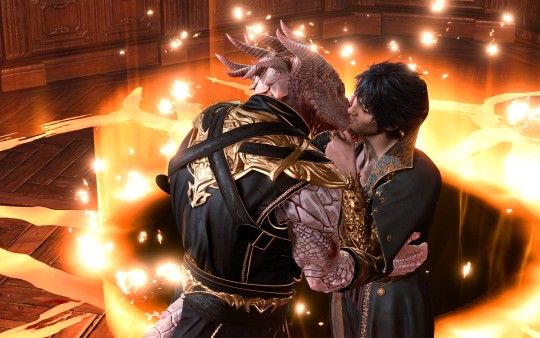
A smooch before going to hell (literally)
#durgetash#enver gortash#gortash#the dark urge#durge#default durge#my posts#bg3#the lighting and the room itself made taking screenshots of this scene irritating so this is one of the few I took and the only half-decent
381 notes
·
View notes
Photo
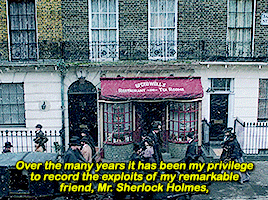
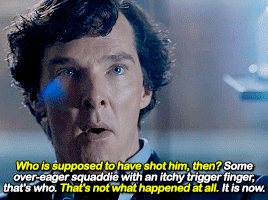
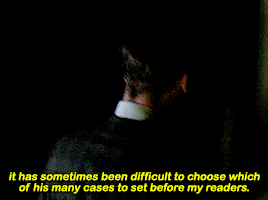


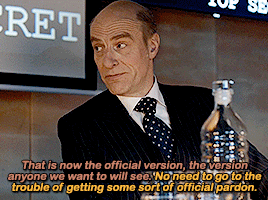
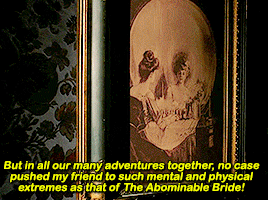
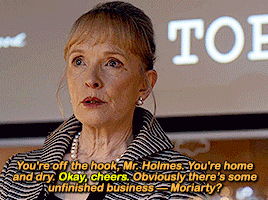
Looking Closer at How The Abominable Bride Foreshadowed and Can Be Used to Chronologically Decode Series 4:
In the opening of TAB, Sherlock imagines John narrating how as Sherlock’s biographer he picks and chooses which of his cases to present to the public, alluding to the nature of John as an unreliable narrator in the canon.
In the opening of TST, John writes Lady Smallwood and co. talking about modifying the footage of Sherlock shooting Magnussen and that their story will become the official one, setting up the nature of John as an unreliable narrator in series 4.
[Continue below the cut for more ➤]
See also: 10 Revealing Things From The Six Thatchers That Haunt You Late At Night, 10 Revealing Things From The Lying Detective That Haunt You Late At Night, and 10 Revealing Things From The Final Problem That Haunt You Late At Night. (#tw suicide)
Bonus: They’re not there:

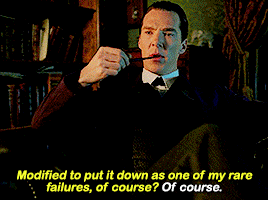

On John’s blog, he wears his heart on his sleeve. He adores Sherlock and clearly loves him even when he tries to downplay their relationship or play up his relationship with Mary. In his post about meeting Sherlock, he calls him “strangely likeable”, and talks like there’s life in for the first time in ages after multiple blog posts about how nothing happens to him.
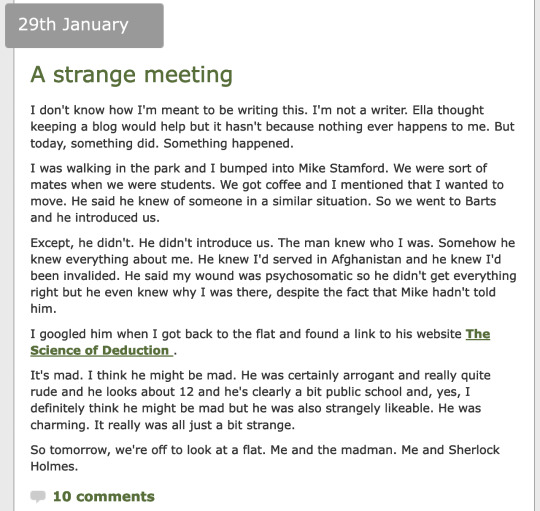
This includes how John thinks that Sherlock not only doesn’t love him back, but that he’s “spectacularly ignorant” about some things, including the way that he feels about Sherlock. How does the world’s only genius consulting detective not notice that? John is pretty forward about this is in one of his early blogs and first one about Sherlock’s cases.
He also says for the first time that he has to omit certain things in order to publish the story at all, echoing the nature of the original stories.
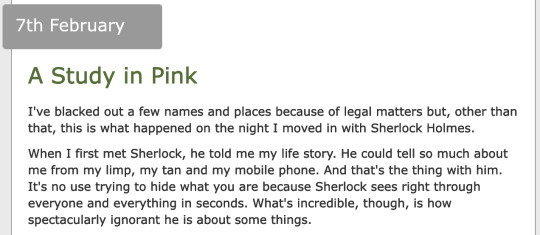
But Watson doesn’t say this in the opening of A Study In Scarlet; he straight-forwardly talks about his return from overseas and his meeting Sherlock Holmes, followed by the case that changes his life. It’s really in the other stories that Watson talks more about altering details, which is what the debate around his authorship revolves around.
It does provide an interesting comparison, though, the way that Sherlock hasn’t yet become the emotionless machine that the myth surrounding Sherlock Holmes is so obsessed with. He laughs, he dances, he expresses emotion alongside his deductions. The last line about Sherlock actually says, “Didn’t I tell you so when we started?” cried Sherlock Holmes with a laugh. “That’s the result of all our Study in Scarlet: to get them a testimonial!”
That changes with The Sign of Four. The opening of the second novel, following the success of the first, is about Holmes and Watson talking about the publication of their first case together.
Holmes: “Yes, indeed,” said I, cordially. “I was never so struck by anything in my life. I even embodied it in a small brochure with the somewhat fantastic title of ‘A Study in Scarlet.’ ”He shook his head sadly. “I glanced over it,” said he.
Holmes: “Honestly, I cannot congratulate you upon it. Detection is, or ought to be, an exact science, and should be treated in the same cold and unemo-
tional manner. You have attempted to tinge it with romanticism, which produces much the same effect as if you worked a love-story or an elopement into the fifth proposition of Euclid.”
Watson: “But the romance was there,” I remonstrated. “I could not tamper with the facts.”
Holmes: “Some facts should be suppressed, or at least a just sense of proportion should be observed in treating them. The only point in the case which deserved mention was the curious analytical reasoning from effects to causes by which I succeeded in unraveling it.”
Watson: I was annoyed at this criticism of a work which had been specially designed to please him. I confess, too, that I was irritated by the egotism which seemed to demand that every line of my pamphlet should be devoted to his own special doings. More than once during the years that I had lived with him in Baker Street I had observed that a small vanity underlay my companion’s quiet and didactic manner. I made no remark, however, but sat nursing my wounded leg. I had a Jezail bullet through it some time before, and, though it did not prevent me from walking, it ached wearily at every change of the weather.
As Sherlock Holmes becomes more of a text, the more Watson mentions about how he to change names, dates, details, or wait until certain people are dead until his stories are published, to protect international secrets and the lives of its characters. But it all started with Holmes and Watson in a flat, talking about how the romance should be suppressed.
In one of John’s early blogs he mentions a fortune cookie at the end, pulling a quote from The Valley of Fear:
“Everything comes in circles—even Professor Moriarty. Jonathan Wild was the hidden force of the London criminals, to whom he sold his brains and his organization on a fifteen per cent. commission. The old wheel turns, and the same spoke comes up. It's all been done before, and will be again. I'll tell you one or two things about Moriarty which may interest you.”

Except John says he think it’s going to be different this time. This version is going to do something different before. It’s going to admit that the romance was there. It’s not going to suppress it anymore by the end. But before it gets there, the story is also about how much, and what therein, the story is being altered in the first place. Enter series 4.
An important blog entry to understanding the mindset of Sherlock and John after series 3 is the last blog entry. To date, the blog is still suspended because if it continued the true nature and mystery of series 4, the answer would be spoiled.
It reads as follows:

Sherlock is openly disinterested and angry at the wedding to anyone who’s paying attention. And not without reason.
The ending of TSOT is one of the most devastating moments in the show. John and Sherlock both realize that neither of them wanted this marriage to happen, that they could have been together and in this passing look they know it’s moments too late after Sherlock realizes Mary is pregnant.
It happens and disappears in a moment.
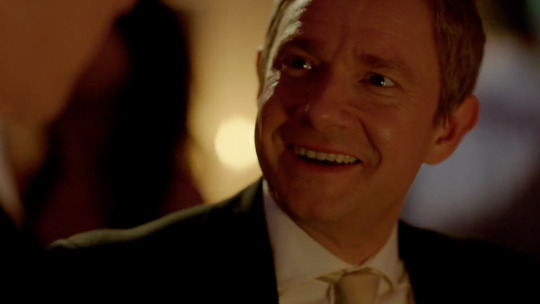
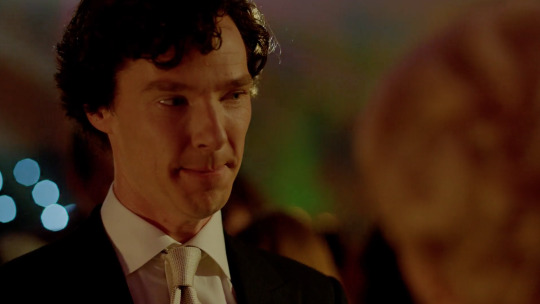
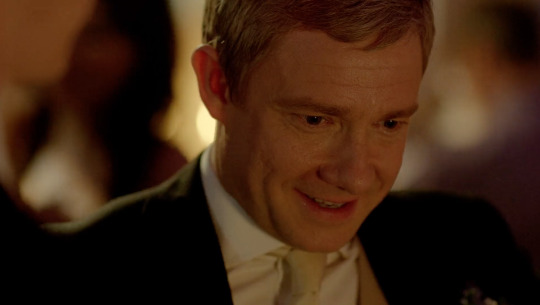
Sherlock leaves the wedding early. A month and one honeymoon later, John will be bursting to get out of his trainwreck of a marriage at every waking moment. He’ll bike to work. He’ll keep his bags packed. When he rejoins Sherlock in the flat he’s practically giddy, and then when he meets Janine and Sherlock explains that he used her later, he’s right back at wondering if Sherlock is capable of loving anyone or not.
And none of this is remotely mentioned in the blog entry. Sherlock takes over for John, foreshadowing that the next act of the show is about to retell The Casebook of Sherlock Holmes, which includes two stories entirely narrated by Holmes. HLV is one of the most devastating episodes of the show and it’s not on the blog at all. The public doesn’t know anything about what happened to them.
The next time we see John’s blog it’s going to say this. Absolutely nothing about their time gone, what Sherlock did or what John is going through. Of course, nothing about Mary either. He isn’t even typing anything like normal; he just fidgets his two fingers on the same two keys, and his blog isn’t on the screen. It’s a screenshot. Because what we’re watching is the blog itself.
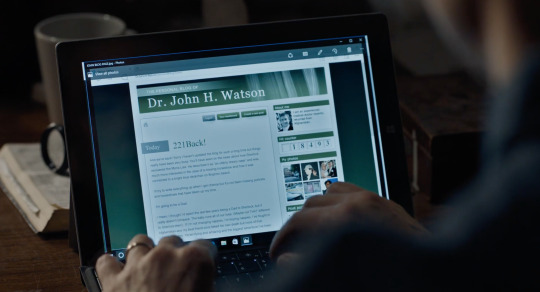
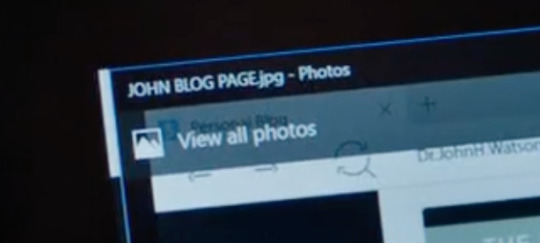
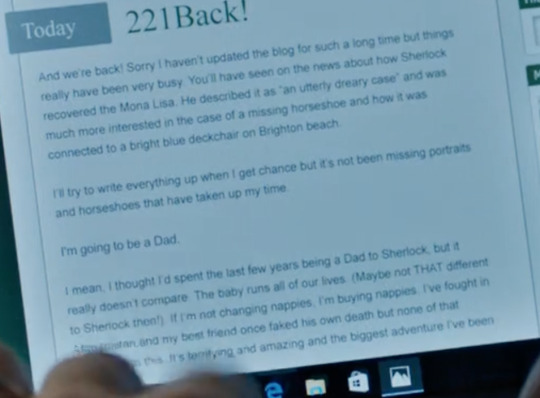
So the parallel starts thus:
After setting up his dream world and arriving at 221B Baker St., and a conversation with Mrs. Hudson about the way that John modifies people to be characters in his story, Sherlock imagines John giving the following narration
Watson: Over the many years it has been my privilege to record the exploits of my remarkable friend, Mr. Sherlock Holmes
The beginning is about putting up the front of John’s purpose and their relationship, calling Holmes his remarkable friend. In the next episode, John as the author takes liberties of his own in order to protect the people in it. He protects himself and Sherlock by covering up the true events of Mary’s death.

In TST, the opening scene is about doctoring the footage of Sherlock shooting Magnussen. With a bright projector light behind Sherlock’s head, the footage cuts out Sherlock putting the trigger as someone walks past the camera. This is being displayed as top-secret information as all of them sit inside a glass window room anyone could sit through.
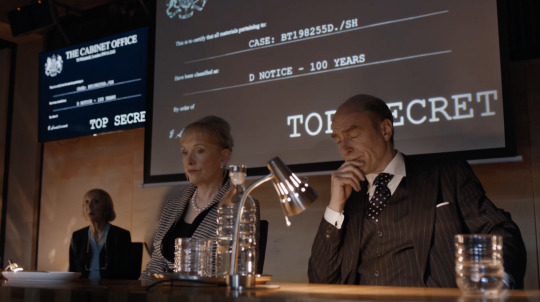
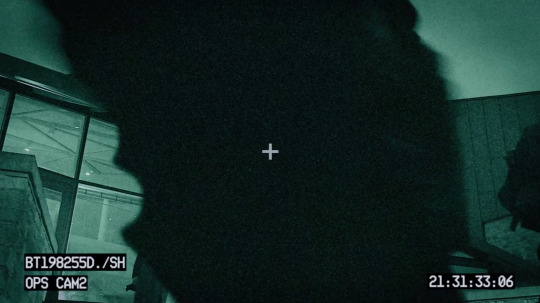
Sherlock and Mycroft describe how it’s different:
I see. Who is supposed to have shot him, then?
Some over-eager squaddie with an itchy trigger finger - that's who.
The over-eager shooter in this story has already conveniently been placed in the room. She has her own pen and paper, but isn’t writing anything down, which is her job as a secretary. It’s because a copy of that text, this conversation should exist, but it doesn’t, because Norbury doesn’t exist. Mycroft tells her not to write it down and put down it down, because once they’re beyond these walls, they must “never speak of it.” There’s also the meaning of Mark Gatiss being a stand in for the show’s writers, similar to the meaning of when John finds the dog’s bones, a correlation to Emelia Ricoletti’s grave being a switch.
It also creates a connection between John the author and Norbury. She’s the one with the pen and she’s going to take the fall, but John is the one who really shot Mary.

Back in TAB, John continues about how he picks and chooses cases to tell:
Watson: it has sometimes been difficult to choose which of his many cases to set before my readers.
That includes, as far as we know right now, the entirety of HLV. He leaves out Magnussen, Mary shooting Sherlock, Mary’s past, and Sherlock shooting Magnussen at once. It’s not just about the cases though, it’s about other things that John leaves out of his story.
In Sherlock’s mind: it’s not just smaller things that John says, like Sherlock being “spectacularly ignorant” about certain things and wounding his ego or embarrassing him, it’s that John never picks up on how much Sherlock loves him. John is hiding the true nature of their relationship from the world because he doesn’t see all the deductions of how much Sherlock loves him back.
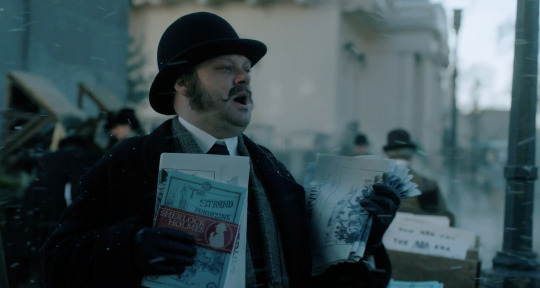

Immediately after the credits in TAB John is praised by for the success of the Adventure of the Blue Carbuncle by a man selling Sherlock Holmes branded content in The Strand Magazine, asking if “there’s going to be a proper murder next time.” He inquires if Sherlock is in the carriage at sight of his profile, the same one printed on the paper he’s carrying, and John dismisses him at Sherlock’s behest. That particular story is from the first short story collection, after A Study In Scarlet and The Sign of Four, and before Sherlock’s presumed death in The Final Problem.
“Remarkable. How did you do it?”
“We have some very talented people working here. If James Moriarty can hack every TV screen in the land, rest assured we have the tech to doctor a bit of security footage.”
John isn’t just talking about how easy it is to doctor footage, but that it’s even easier for him to do as a writer with words. He doesn’t need any government technology to alter the story. All he needs to do is the essence of this scene – lie and invent. Like when John invents the story about Eurus in order to lie about what happened to him where he has a pen and paper.
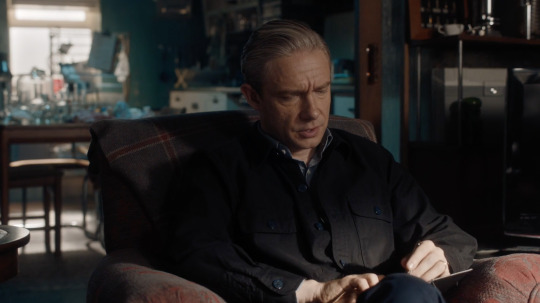
Watson admits the reason he has to do this back in TAB:
“Some are still too sensitive to recount, whilst others are too recent in the minds of the public.”
At the end of the story, Sherlock will ask to make sure that Watson modified the story, to “put it down as one of my rare failures, of course?” The story was progressing like a normal adventure until Sir Eustace’s murder, and then the entire second half of the story was omitted. Sherlock helped Lady Carmichael get away with murdering her husband. He broke his vow, it’s one of his “rare failures”. Sherlock is imagining their marriage in order to try to predict what would happen in the near future and what danger John would be in.
Mary is the case and she becomes the case the next episode. It’s at this point in TAB that we see a shot of the knife in the mantle – connecting to TLD when Mary’s case, the message tied to the dagger, or the case on how to save John, is the one Sherlock still hasn’t solved. The knife is still there in the fake ending of TFP. John thinks he still hasn’t solved it and that’s why he was shot at the end of TLD.
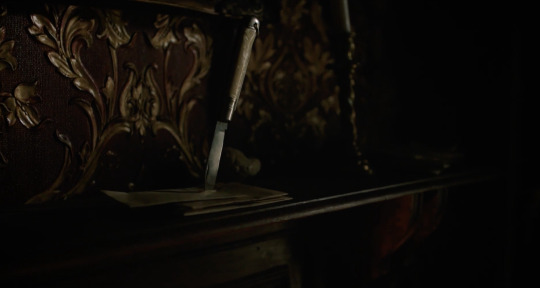
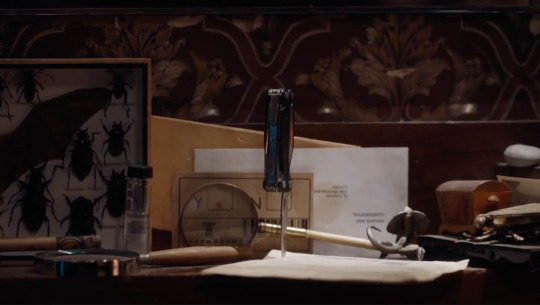

Mary is Sir Eustace with the dark past coming back to haunt her. Mary is the post-humous revenge Sherlock alluded to, the vengeful bride who faked her death to kill her husband, the figure of Death in the Samarra story, and half the ultimate villain – but some cases are still too sensitive to properly recount. Moriarty isn’t back. No, no, no. He’s definitely dead. He planned his revenge on Sherlock five years ago by filming a bunch of reaction gifs and jiving against the glass with Eurus like a snake.
The next episode, Mary’s past comes back to haunt her, and Sherlock breaks his vow. One of his “rare failures”. The over-eager shooter is hauled away as the projector lights the back of her head.


Mary’s death isn’t the only case that John covers up, however. He manages to do that relatively consistently. Even with how on the nose it is, the audience was convinced. The most convincing case is the one that John doesn’t show at all; the cover-up of his own death.
In TST, it’s clear this is about getting away with murder:
That is now the official version, the version anyone we want to will see.
No need to go to the trouble of getting some sort of official pardon.
Lady Carmichael doesn’t have to bother with a pardon and neither does John. His cover-up story, The Final Problem, is an entirely invented entry in the great Sherlock saga, using the name of a real one as a red herring, ending their story and establishing normalcy so no one will know what happened to him next. Series 4 is what happened, officially. But it’s not the truth. John has modified the truth. The romance has been suppressed.


John can’t tell that story because he has to make it convincing enough to draw Mary into the open; he doesn’t want to go to the trouble of getting a pardon when he has to face her again. This has to be the version everyone believes so that when it’s revealed that John committed suicide, everyone believes that too.
John has let his insecurities, self-hatred, and suicidal ideation leak into the subtext of series 4, so that when the news gets out about what really happened, and that the last story in particular was a total fabrication, people believe the secret story hidden beneath the true one. Suddenly the decline of hi stories becomes the tragic tale of a man losing his way and taking his lie. The story ends on a low note. “It’s gone a bit downhill, hasn’t it?” And it is emotionally true, but it’s all part of John’s bigger plan to fake his death.
When Eurus as Faith gives Sherlock the note about Culverton Smith she writes one story on the surface, the one that Sherlock deduces, but hides another message underneath that he doesn’t see until it’s too late. This is the case he didn’t solve.
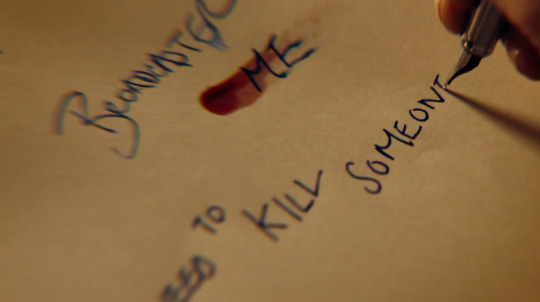

This is what John’s story is: one text subsumed by another bubbling just beneath its surface. When John’s original story falls through because of what happened at the end of TLD, darkness completely overwhelms his story in TFP. Sherlock is drowning in it until he ties a nice bow on the ending. One coverup hiding another coverup. That’s how you sell a big lie; you wrap it in the truth to make it more palatable.
One of John’s blog entries has a picture of the knife stabbed into a clue board. Sherlock figured out that the victim faked his own death.
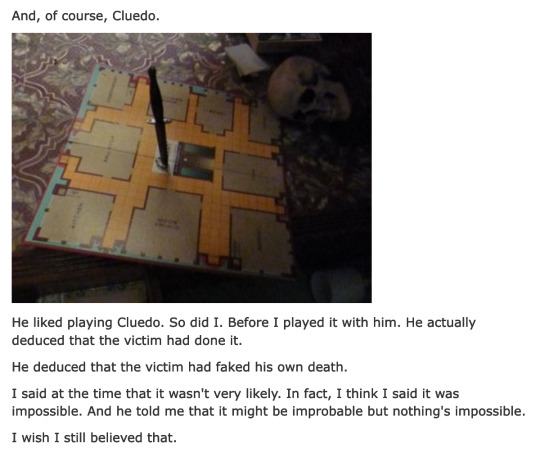
TAB foreshadows the lengths John goes to:
But in all our many adventures together, no case pushed my friend to such mental and physical extremes as that of The Abominable Bride!"
Sherlock is pushed all the way to the predestined end of the story, clinging to life at the Reichenbach Falls with Moriarty punching him down. It’s only when he decides to let John in emotionally that he appears, foiling him easily, kicking over the falls like he isn’t a threat at all. Because he isn’t when they’re together and they openly love each other.
John doesn’t have the same confidence. John thinks that he can’t avoid Samarra – that even if he fakes his death, that happy ending he invents at the ending of TFP is the closest to happiness that he’s ever going to get. Sherlock has more confidence in John and what they can accomplish together. “I’m a storyteller. I know when I’m in one.” The real John knows it too, but he can’t see the same ending Sherlock does if he still doesn’t know Sherlock loves him back. John’s ending is a dark mirror and denial of Sherlock’s hopeful vision.
Nothing has pushed John to such mental and physical extremes as that of the abominable bride. Mary faking her death, returning to manipulate and gaslight him, and trying to get him to commit suicide to burn Sherlock’s heart out of him forever is the worst thing that John’s ever been through. The most trying case in his career working with Sherlock. Faking his death, however, isn’t the end. Because the whole point in all of this is to outsmart Mary and Moriarty, drawing them into the open so John can make his move.
Smallwood: “You're off the hook, Mr Holmes. You're home and dry.”
Sherlock: “OK, cheers.”
Smallwood: “Obviously, there's unfinished business. Moriarty?”
For Sherlock, his unfinished business is Moriarty. For John, it’s Mary. They’re going to have to work together to finally defeat them once and for all – and they can only do that once they both know the truth. Nothing can stop them. Then the spoke will turn, and the world will have something new.
But for now, the truth has to be modified. The romance has to be suppressed. Until the world is convinced John is dead and he’s in the clear.
“That’s not what happened at all.”
“It is now.”
#sherlockedit#tjlcedit#johnlockedit#sherlock bbc#tjlc#john watson#sherlock holmes#mary morstan#vivian norbury#meta#the abominable bride#the six thatchers#edits#gifset#gifs#looking closer at tab timeline#television#john's blog#series 4
90 notes
·
View notes